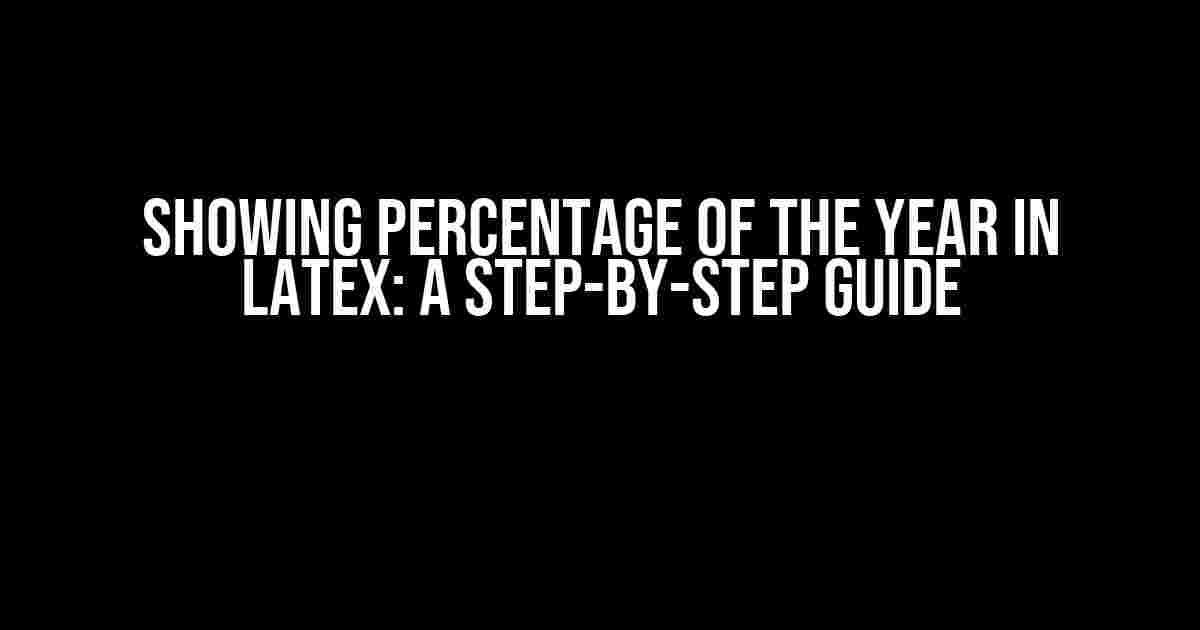Are you tired of manually calculating the percentage of the year that has passed? Do you want to impress your friends and colleagues with your LaTeX skills? Look no further! In this article, we will show you how to display the percentage of the year in LaTeX, making your documents and presentations stand out.
Why use LaTeX?
LaTeX is a powerful document preparation system that offers a wide range of features and customization options. With LaTeX, you can create professional-looking documents, presentations, and posters with ease. One of the most significant advantages of LaTeX is its ability to automate calculations and display them in a visually appealing way.
The Problem: Calculating the Percentage of the Year
Calculating the percentage of the year that has passed can be a daunting task, especially when you have to do it manually. You need to take into account the current date, the number of days in the year, and the number of days that have passed. It’s a lot of work, and it’s easy to make mistakes.
The Solution: Using LaTeX’s calc Package
LaTeX’s calc package offers a simple and elegant solution to this problem. The calc package allows you to perform arithmetic operations on LaTeX counters, which can be used to calculate the percentage of the year.
\documentclass{article}
\usepackage{calc}
\newcount\days
\days=\day
\newcount\year
\year=\year
\newcommand{\percentofyear}{%
\the\numexpr ( \days / 365 ) * 100 \%
}
\begin{document}
The percentage of the year that has passed is: \percentofyear
\end{document}
Breaking Down the Code
Let’s take a closer look at the code snippet above:
\newcount\days: Creates a new counter calleddays, which will store the current day of the year.\days=\day: Assigns the current day of the year to thedayscounter.\newcount\year: Creates a new counter calledyear, which will store the current year.\year=\year: Assigns the current year to theyearcounter.\newcommand{\percentofyear}{...}: Defines a new command called\percentofyear, which will calculate and display the percentage of the year.\the\numexpr ( \days / 365 ) * 100 \%: Calculates the percentage of the year by dividing the current day by 365 (the number of days in a year) and multiplying by 100. The result is then displayed as a percentage.
Customizing the Output
You can customize the output of the \percentofyear command to suit your needs. For example, you can round the result to a specific number of decimal places or add a caption to the output.
Rounding the Result
LaTeX provides several ways to round numbers to a specific number of decimal places. One common method is to use the \round command from the fp package.
\documentclass{article}
\usepackage{calc}
\usepackage{fp}
\newcount\days
\days=\day
\newcount\year
\year=\year
\newcommand{\percentofyear}{%
\FPround{\percent}{\the\numexpr ( \days / 365 ) * 100 }{2}%
\percent\%
}
\begin{document}
The percentage of the year that has passed is: \percentofyear
\end{document}
Adding a Caption
You can add a caption to the output by using the \caption command or by defining a custom command.
\documentclass{article}
\usepackage{calc}
\newcount\days
\days=\day
\newcount\year
\year=\year
\newcommand{\percentofyear}{%
The percentage of the year that has passed is: \the\numexpr ( \days / 365 ) * 100 \%
}
\begin{document}
\percentofyear
\end{document}
Common Pitfalls
When working with LaTeX’s calc package, there are a few common pitfalls to avoid:
- Integer Division: LaTeX’s calc package performs integer division, which means that any fractional part of the result is truncated. To avoid this, use the
\FProundcommand or thefpevalpackage. - Counter Overflow: If the result of the calculation exceeds the maximum value of the counter, LaTeX will raise an error. To avoid this, use a larger counter or redefine the counter to have a larger range.
- Calculation Errors: Make sure to check your calculations for errors, especially when working with complex formulas.
Conclusion
In this article, we have shown you how to display the percentage of the year in LaTeX using the calc package. With this powerful tool, you can create professional-looking documents and presentations that showcase your LaTeX skills. Remember to customize the output to suit your needs, and avoid common pitfalls to ensure accurate results.
| Package | Description |
|---|---|
| calc | Provides arithmetic operations on LaTeX counters |
| fp | Provides floating-point arithmetic operations |
| fpeval | Provides a more powerful and flexible alternative to the calc package |
Happy LaTeX-ing!
Here is the output:
Frequently Asked Question
Get ready to master the art of showing percentage of the year in LaTeX, the ultimate typesetting system!
How do I show a percentage sign in LaTeX?
You can use the percent symbol \% to show a percentage sign in LaTeX. For example, \text{25\%} will produce a 25% sign.
Can I use the percent symbol with other numbers in LaTeX?
Absolutely! You can use the percent symbol with other numbers in LaTeX. For example, \text{75.5\%} will produce a 75.5% sign. Just make sure to escape the percent symbol with a backslash.
How do I show a year with a percentage sign in LaTeX?
You can use the year followed by the percent symbol in LaTeX. For example, 2022\% will produce 2022%. Simple as that!
Can I use different fonts for the percentage sign in LaTeX?
Yes, you can! LaTeX provides different font styles and families that you can use to customize the appearance of the percentage sign. For example, you can use \textit{25\%} for an italic font or \textbf{25\%} for a bold font.
Are there any LaTeX packages for showing percentages?
Yes, there are several LaTeX packages available for showing percentages, such as the `siunitx` package, which provides a \percent command for typesetting percentages. You can also use the `fontspec` package to customize the font and appearance of the percentage sign.

